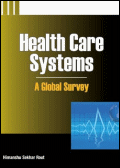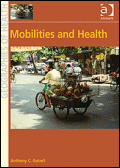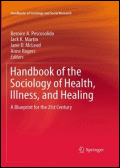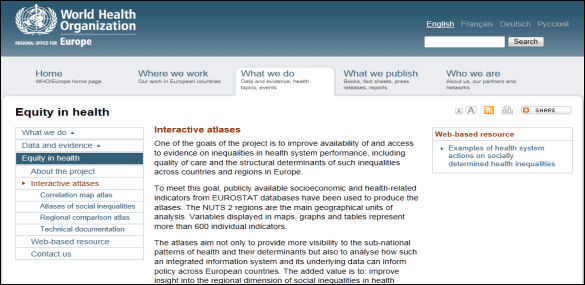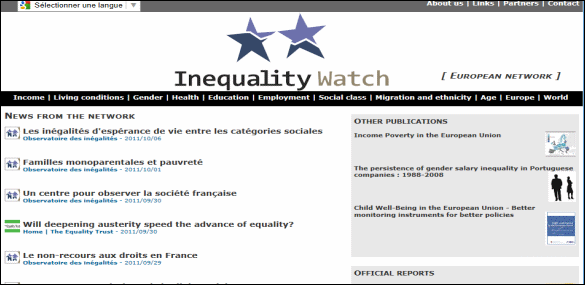LU POUR VOUS D'OCTOBRE 2011 :
 livres du mois
livres du mois
 sites du mois
sites du mois
 working papers
working papers
Tous les lu pour vous
LES LIVRES DU MOIS
The Oxford Handbook of Health Economics.
Glied S., Smith P.C.
Oxford : Oxford University Press : 2011 : 24 p.+ 967 p.
The Oxford Handbook of Health Economics provides an accessible and authoritative guide to health economics, intended for scholars and students in the field, as well as those in adjacent disciplines including health policy and clinical medicine. The chapters stress the direct impact of health economics reasoning on policy and practice, offering readers an introduction to the potential reach of the discipline. Contributions come from internationally-recognized leaders in health economics and reflect the worldwide reach of the discipline. Authoritative, but non-technical, the chapters place great emphasis on the connections between theory and policy-making, and develop the contributions of health economics to problems arising in a variety of institutional contexts, from primary care to the operations of health insurers. The volume addresses policy concerns relevant to health systems in both developed and developing countries. It takes a broad perspective, with relevance to systems with single or multi-payer health insurance arrangements, and to those relying predominantly on user charges; contributions are also included that focus both on medical care and on non-medical factors that affect health. Each chapter provides a succinct summary of the current state of economic thinking in a given area, as well as the author's unique perspective on issues that remain open to debate. The volume presents a view of health economics as a vibrant and continually advancing field, highlighting ongoing challenges and pointing to new directions for further progress (4e de couverture).
Health Care Systems. A global survey.
Les systèmes de santé. Une enquête mondiale.
Rout H.S.
New Delhi : New Century Publications : 2011 : 619 p.
Health care systems (HCSs) are essential for the healthy development of individuals, families, and societies in accordance with human rights. HCSs are vital to establish, promote, and strengthen the delivery of preventive health services to all sections of society in a fair and equitable manner. This book contains well-researched papers on HCSs in different countries of the world. The distinguished contributors have direct knowledge and experience of the functioning of HCSs in their respective countries. The countries profiled are: the US, Australia, China, France, Germany, Hungary, Ireland, Israel, Japan, South Korea, Portugal, Spain, Brazil, Mexico, Pakistan, Peru, Thailand, Turkey, Bangladesh, Ghana, and India. While treatment of the subject varies from country to country, depending upon the local conditions and government policies, some common features are discernible in the contributions. These include: the history and present organizational structure/management of HCSs, health care financing and resource utilization targeted health care programs for the poor, health infrastructure, indigenous/traditional HCSs, occupational health and health sector reforms.
Mobilities and health.
Mobilités et santé.
Gatrell A.C.
Farnham : Ashgate Publishing Limited : 2011 : 12 p.+229 p.
Looking at health and health care in a new way, this book examines health risks and benefits as encountered 'on the move' rather than focusing on the risks and benefits incurred at fixed locations. The provision and utilization of health care is also investigated, as produced/delivered and consumed/accessed in mobile settings. Engaging with the contemporary concern with 'mobilities' this book covers many forms of movement and flow, including movements of people, disease, information and health care. The issues and problems which are considered - whether re-emerging infections, displaced persons, or the 'risks' of globalised travel - are of current and ongoing concern. Drawing on three main disciplines, geography, sociology, and epidemiology, author Tony Gatrell makes strong connections between these areas of inquiry, drawing on (for example) social theorising, geographical concepts, and epidemiological methods and data. The book will be of interest to the growing number of geographers working on the geography of health, along with social scientists involved in the mobilities 'turn'. More broadly, as issues of global public health that invariably involve the movements of people, goods, viruses and information continue to hit the headlines, the book is both timely and of policy relevance (4e de couverture).
Handbook of the sociology of health, illness, and healing.
Pescosolido B.A., Martin J.K., McLeod J.D., Rogers A.
New York : Springer : 2011 : 12-571 p.
The Handbook of the Sociology of Health, Illness Healing advances the understanding of medical sociology by identifying the most important contemporary challenges to the field and suggesting directions for future inquiry. The editors provide a blueprint for guiding research and teaching agendas for the first quarter of the 21st century. In a series of essays, this volume offers a systematic view of the critical questions that face our understanding of the role of social forces in health, illness and healing. It also provides an overall theoretical framework and asks medical sociologists to consider the implications of taking on new directions and approaches. Such issues may include the importance of multiple levels of influences, the utility of dynamic, life course approaches, the role of culture, the impact of social networks, the importance of fundamental causes approaches, and the influences of state structures and policy making (4e de couverture).
Health care financing and insurance. Options for design.
Financement des soins de santé et assurance.
Paolucci F.Berlin: Springer : 2011 : 115 p.
As a contribution to the search for suitable and sustainable solutions to finance rising medical care expenditures, the book proposes a typology of healthcare financing and insurance schemes, based on the dimensions of basic vs. supplementary services and mandatory vs. voluntary coverage, to analyse the design and the complex interactions between various financing and insurance arrangements in several OECD countries. This study provides a better understanding of the strengths and weaknesses of the financial and organisational structures of different countries' healthcare financing and insurance schemes. Its main contributions are the development of a novel and rigorous theoretical framework analysing the economic rationales for the optimal design of healthcare financing and insurance schemes, and an empirical and institutional analysis investigating the consequences for efficiency and affordability of the complex interactions between basic and supplementary sources of financing (4e de couv.)
Professionnels de santé et analyse des pratiques.
Chami J., Fablet D.
Paris : L'Harmattan : 2011 : 198 p.
Voici le onzième ouvrage collectif sur l'analyse des pratiques professionnelles, consacré celui-là aux professionnels de santé. Il vise à explorer diverses professions concernées : médecins, infirmiers, psychologues. Quel rôle joue aujourd'hui l'analyse des pratiques dans la formation initiale et continue de ces professions ? L'investigation s'est portée sur ces catégories professionnelles qui subissent des évolutions croissantes, mais aussi sur la diversité des champs d'exercice : pratiques libérales, hospitalières, mixtes (4e de couverture).
Le nouvel ordre protectionnel : de la protection sociale à la sollicitude publique.
Vrancken D.
Lyon : Parangon/Vs : 2011 : 182 p.
Certes, nos sociétés européennes offrent encore largement des régimes de protection sociale. Mais ces derniers sont traversés par des mouvements d'inflexion qui conduisent à poser l'existence d'un nouvel ordre protectionnel. Traversé par de nombreuses contradictions, ce nouvel ordre protectionnel se cherche. Il se déclinerait ainsi comme un ordre biographique qui tente de s'installer au plus près des trajectoires et des parcours de vie. Enfin, le nouvel ordre protectionnel serait d'ordre fictionnel, il se nourrirait d'images, de représentations à l'horizon desquelles viendrait désormais poindre la sollicitude (Résumé d'auteur.)
Régulation et tarification des hôpitaux.
Mougeot M., Naegelen F., Leclercq B.
Paris : Economica : 2011 : 152 p.
La maîtrise des dépenses de santé est un des problèmes principaux des économies développées. Elle peut cependant entrer en conflit avec la recherche d'une meilleure qualité des soins permettant d'améliorer l'état de santé de la population. Ce livre analyse les arbitrages que doit réaliser, dans ce contexte, toute politique de tarification des hôpitaux, compte tenu des asymétries d 'information qui caractérisent la relation entre les tutelles et les producteurs de soins. Les arguments concernant les choix entre des contrats de remboursement des coûts et des contrats forfaitaires sont d'abord analysés dans le cas d'hôpitaux et de patients homogènes. Les hétérogénéités sont ensuite prises en compte de manière à mettre en évidence la nécessité de mécanismes de financement plus complexes arbitrant entre la recherche de l'efficacité productive et de l'efficacité allocative, la dissuasion de la sélection des patients et l'élimination des rentes socialement coûteuses . L'ouvrage apporte ainsi un éclairage théorique nouveau sur les politiques retenues en France depuis quelques années et sur les améliorations qui pourraient leur être apportées (Résumé de l'éditeur).
LES SITES DU MOIS D'OCTOBRE
Atlas interactifs de l'OMS sur l'équité en santé en Europe
www.euro.who.int/en/what-we-do/data-and-evidence/equity-in-health/interactive-atlases
Presentation
Le bureau OMS Europe a développé ce projet afin d'améliorer la disponibilité et l'accès aux éléments de preuve sur les différences de performance des systèmes de santé en Europe et ses régions. Pour atteindre cet objectif, des indicateurs socio-économiques et sanitaires accessibles au public des bases de données EUROSTAT ont été utilisées pour produire les Atlas. Les régions NUTS 2 (Nomenclature d'unités territoriales statistiques) sont les principales unités géographiques de l'analyse. Ces variables, affichées dans des cartes, des graphiques et des tableaux, représentent plus de 600 indicateurs individuels.
3 atlas à disposition:
1- Atlas des cartes de corrélation : il permet une visualisation rapide de deux variables dans des cartes et leur association dans un graphe, où l'analyse de corrélation peut également être effectuée. Une fonction de filtre pour ne sélectionner qu'un seul pays ou groupe de pays est disponible.
2- Atlas des cartes de Atlas des inégalités sociales : il permet la visualisation de la différence entre la valeur cible et la valeur dans une région ou un groupe de régions. La valeur cible est la moyenne pondérée de population du quintile de population la plus favorisée. Les différences entre la cible et de la région individuelle sont visualisés comme des différences absolues (différences de zones cibles) et des différences relatives (taux de zones cibles).
3- Atlas de comparaison régionale : il permet une comparaison rapide de plusieurs indicateurs clés entre un nombre limité de régions. Il faut utiliser la touche Ctrl et la souris pour sélectionner les régions d'intérêt.
Ces trois atlas sont complétés par une base de données d'exemples d'actions menées pour lutter contre les inégalités sociales de santé.
Inequality watch
http://inequalitywatch.eu/
Presentation
Fruit d'un partenariat entre associations et centres de recherche européens L'Observatoire européen de l'inégalité, est le premier réseau européen indépendant d'information sur les inégalités.
L'objectif est de proposer gratuitement à l'ensemble des citoyens européens (scientifiques, acteurs associatifs, acteurs économiques, pouvoirs publics, et à l'opinion publique de manière plus générale) les publications les plus pertinentes sur le thème des inégalités en Europe. Le site met à disposition les données collectées et les analyses produites sur les inégalités indépendamment par chaque membre du réseau. Le site met ainsi à disposition des informations pour appréhender l'évolution et la situation actuelle des inégalités classées par rubrique (revenu, conditions de vie, genre, santé, éducation, emploi, immigrés et étrangers, âge, Europe et monde). Outre un fil d'actualités proposant les nouvelles publications des membres du réseau, des dossiers thématiques seront publiés. Des conférences ouvertes au public, réunissant scientifiques et acteurs de terrain, seront par ailleurs organisées dans le but d'informer et de réfléchir autour du thème des inégalités.
VU DE L'ETRANGER : QUELQUES WORKING PAPERS ANALYSES
Economie de la santé
Demand and Pricing of Preventative Healthcare. 

Demande et prix des soins de santé préventifs.
Vandoros S., Carman K.G.
London : London School of Economics and Political Science : 2011/05 : 31 p.
This study introduces a theoretical framework for the economics of preventative healthcare. Mathematical models are used to explain how the price and utilization of prevention change depending on demand, as well as factors such as the price of a cure, the probability of illness, the efficacy of treatment, the probability of illness and cost functions. Different models are developed depending on the presence and level of health insurance and competition in preventative healthcare markets. Findings show the effect of various factors on the price of preventative healthcare, reveal the marginal effects of a change in the parameters on prices and suggest that under certain circumstances prevention is not the optimal choice. This paper sets out a simple model to compare prices of preventative care across various regimes. In an environment of rising health costs, prevention is very important as it decreases the likelihood of need to cure illnesses in the future. However, prevention is not always the best solution, as costs may be too high compared to cure and disutility of illness, taking into account the probability of illness, while depending on the source of demand and the level of insurance cover, quantities of prevention purchased and the number of people covered may differ significantly.
Hôpital
Investigation of the Impact of the Massachusetts Health Care Reform on Hospital Costs and Quality of Care. 

Enquête sur l'impact de la réforme du système de santé dans le Massachussets sur les coûts hospitaliers et la qualité des soins.
Miller F., Wang J.
Rochester : Social Science Electronic Publishing : 2011 : 30 p.
In 2006, the Massachusetts legislature passed a landmark health care reform bill (the Reform) that has served as a model for the national health care reform. By aiming to provide “access to affordable, quality, accountable health care,” the goals of this reform were to reduce the number of uninsured Massachusetts residents while containing health care costs and improving the quality of health care services. This bill has been the subject of much controversy at both the national and state level. Although most agree that the Reform has improved the insurance coverage rate of Massachusetts residents, the financial impact of the Reform has been of special concern with critics arguing that the Reform has increased the overall cost of health care. Despite this scrutiny, it is still unclear whether the goals of the Reform have been achieved. We propose to test a subset of the Reform's goals by examining at the hospital level whether the Massachusetts Health Care Reform has achieved its cost containment and quality improvement goals. We use Centers for Medicare & Medicaid Services (CMS) and Hospital Compare (HC) data to investigate this issue and study hospital costs and quality for the period spanning 2003 to 2009. To assess the impact of the Reform on costs and quality, we compare the change in Massachusetts hospital costs and quality pre- and post-Reform to changes in two states that provide a similar level of health care quality for the same period (namely, Connecticut and Wisconsin). Data from acute care hospitals show that there is no evidence that Massachusetts total hospital costs or salaries of departments providing clinical services were adversely affected by the Reform. Moreover, we find that quality of care improved for several quality measures post-Reform to a greater extent in Massachusetts than in our control states. In sum, our evidence is consistent with the claim that Massachusetts hospital costs were contained and quality improved subsequent to the Reform. Thus, this study provides preliminary support for the argument that the Reform achieved some of its financial and quality goals.
Inégalités sociales de santé
Redistribution Policy and Inequality Reduction in OECD Countries. What Has Changed in Two Decades? 

Politique de redistribution et réduction des inégalités dans les pays de l'OCDE. Ce qui a changé depuis vingt ans.
Immervoll H., Richardson L.
Paris : OCDE : 2011 : 93 p.
This paper uses a range of data sources to assess if, and to what extent, government redistribution policies have slowed or accelerated the trend towards greater income disparities in the past 20-25 years. In most countries, inequality among "non-elderly" households has widened during most phases of the economic cycle and any episodes of narrowing income differentials have usually not lasted long enough to close the gap between high and low incomes that had opened up previously. With progressive redistribution systems in place, greater inequality automatically leads to more redistribution, even if no policy action is taken. We find that, in the context of rising market-income inequality, tax-benefit systems have indeed become more redistributive since the 1980s but that this did not stop income inequality from rising: market-income inequality grew by twice as much as redistribution. The redistributive strength of tax-benefit systems weakened in many countries particularly in the most recent decade. While growing market-income disparities were the main driver of inequality trends between the mid-1980s and mid-1990s, reduced redistribution was often the main driver in the ten years that followed. Benefits had a much stronger impact on inequality than social contributions or taxes, despite the much bigger aggregate size of direct taxes. As a result, redistribution policies were often less successful at counteracting growing income gaps at the bottom in the top half of the income distribution.
Inégalité de revenu et état de santé : une relation ambiguë. 

Poder T.G.
Sherbrooke : GREDI : 2011/03 : 233-256
Au cours de ces dernières années, de nombreux chercheurs issus de divers domaines des sciences sociales ont posé l'existence d'une relation entre inégalité de revenu et état de santé, l'ont examiné dans des études empiriques et ont commencé à proposer des applications de politiques. Cependant, de nombreuses ambiguïtés persistent et, par conséquent, personne ne sait comment cette relation fonctionne réellement. Dans ce cadre, ce bref article se propose d'enquêter sur ce qui est connu à ce jour sur la relation entre inégalité de revenu et état de santé et offre des suggestions quant à la façon de produire davantage de santé.
The Effect of Education on Health: Cross-Country Evidence. 

L'impact de l'éducation sur l'état de santé : évidences transnationales.
Fonseca R., Zheng Y.
Santa Monica. The Rand : 2011/08 : 24 p.
This paper sheds light on the causal relationship between education and health outcomes. It combines three surveys (SHARE, HRS and ELSA) that include nationally representative samples of people aged 50 and over from thirteen OECD countries. It uses variation in the timing of educational reforms across these countries as an instrument for education. Using IV-Probit models, it finds causal evidence that more years of education lead to a lower probability of reporting poor health and lower prevalence for diabetes and hypertension. These effects are larger than those from the Probit, that do not control for the endogeneity of education. The relationship between education and cancer is positive in both Probit and IV-Probit models. The causal impacts of education on other chronic conditions as well as functional status are not established using IV-Probit models.
Mirror, Mirror, on the Wall, Who in this Land is Fairest of All. Distributional Sensitivity in the Measurement of Socioeconomic Inequality of Health 

Mirroir, mirroir, dis moi quelle est la plus belle. Sensibilité en matière de distribution dans la mesure des inégalités socio-économiques de santé.
Erreygers G., Clarke P., Van Ourti T.
Tilburg : Network for Studies on Pensions, Aging and Retirement : 2011 : 48 p.
This paper explores four alternative indices for measuring health inequalities in a way that takes into account attitudes towards inequality. First, we revisit the extended concentration index which has been proposed to make it possible to introduce changes into the distributional value judgements implicit in the standard concentration index. Next, we suggest an alternative index based on a different weighting scheme. In contrast to the extended concentration index, this new index has the ‘symmetry' property. We also show how these indices can be generalized so that they satisfy the ‘mirror' property, which may be seen as a desirable property when dealing with bounded variables. We empirically compare the different indices for under-five mortality rates and the number of antenatal visits in developing countries.
Comparing the Predictive Power of Subjective and Objective Health Indicators: Changes in Handgrip Strength and Overall Satisfaction with Life as Predictors of Mortality. 

Comparaison du pouvoir prédictif des indicateurs de santé subjectifs et objectifs : évolution de la force de préhension et satisfaction globale de vie comme prédicteurs de la mortalité.
Ambrasat J., Schupp J., Wagner G.G.
Berlin : DIW : 2011/09 : 12 p.
Self-reported measures of health are generally treated as weak measures of respondents' objective health status. On the other hand, most surveys use self-reported health to measure health status and to determine the effects of a range of other socio-economic characteristics of the local environment on individual health. It is therefore of interest to the public health research community to verify the validity of self-reported health data. We do this by analyzing data from a longitudinal household panel survey: the German Socio-Economic Panel Study (SOEP). In 2006, and again in 2008, hand grip strength was measured as part of the SOEP. The hand grip data can be compared with other indicators of health and well-being from the SOEP survey. In a first step, we examine short-term mortality outcomes predicted by changes in handgrip strength. Then we compare the predictive power of the results with those of a subjective indicator of well-being: overall life satisfaction. We find that both measures are related to mortality risk. However, the effects are quite independent. Thus we argue that changes in hand grip strength and overall life satisfaction capture two different aspects of health status and its changes. We therefore test this hypothesis by correlating the indicators with other survey-based health measures that were also taken in the SOEP in 2006 and 2008.
Adverse Selection and Switching Costs in Health Insurance Markets: When Nudging Hurts. 

Handel B.R.
Cambridge : NBER : 2011/09 : 45 p.
This paper investigates consumer switching costs in the context of health insurance markets, where adverse selection is a potential concern. Though previous work has studied these phenomena in isolation, they interact in a way that directly impacts market outcomes and consumer welfare. Our identification strategy leverages a unique natural experiment that occurred at a large firm where we also observe individual-level panel data on health insurance choices and medical claims. We present descriptive results to show that (i) switching costs are large and (ii) adverse selection is present. To formalize this analysis we develop and estimate a choice model that jointly quantifies switching costs, risk preferences, and ex ante health risk. We use these estimates to study the welfare impact of an information provision policy that nudges consumers toward better decisions by reducing switching costs. This policy increases welfare in a naive setting where insurance plan prices are held fixed. However, when insurance prices change endogenously to reflect updated enrollee risk pools, the same policy substantially exacerbates adverse selection and reduces consumer welfare, doubling the existing welfare loss from adverse selection.
Médicaments
Disentangling spillover effects of antibiotic consumption: a spatial panel approach. 

Dénouer les effets en cascade de la consommation d'antibiotique : une approche spatiale de panel.
Gonzalez L., Masiero G.
Lugano : Université de Lugano : 2011 : 22 p.
Literature on socioeconomic determinants of antibiotic consumption in the community is limited to few countries using cross-sectional data. This paper analyses regional variations in outpatient antibiotics in Italy using a balanced panel dataset covering the period 2000-2008. It specifies an econometric model where antibiotic consumption depends upon demographic and socioeconomic characteristics of the population, the supply of health care services in the community, and antibiotic copayments. The model is estimated by means of Ordinary least squares techniques with fixed effects (FE). The implications of consumption externalities across geographical areas are investigated by means of spatial-lag and spatial-error models (SLFE and SEFE). It finds significant and positive income elasticity and negative effects of copayments. Antibiotic use is also affected by the age structure of the population and the supply of community healh care. Finally, it finds evidence of spatial dependency in the use of antibiotics across regions. This suggests that regional policies (e.g. public campaigns) aimed at increasing efficiency in antibiotic consumption and controlling bacterial resistance may be influenced by policy makers in neighbouring regions. There will be scope for a strategic and coordinated view of regional policies towards the use of antibiotics.
Protection sociale
International portability of health-cost coverage : concepts and experience. 

Transferabilité du coût de couverture maladie : concepts et expérience.
Werding M., McLennan S.
Washington : Banque mondiale : 2011 : 78 p.
Social insurance and other arrangements for funding health-care benefits often establish long-term relationships, effectively providing insurance against lasting changes in an individual's health status, engaging in burden-smoothing over the life cycle, and entailing additional elements of redistribution. International portability regarding this type of cover is, therefore, difficult to establish, but at the same time rather important both for the individuals affected and for the health funds involved in any instance of an international change in work place or residence. In this paper, full portability of health-cost cover is taken to mean that mobile individuals can, at a minimum, find comparable continuation of coverage under a different system and that this does not impose external costs or benefits on other members of the systems in the source and destination countries. Both of these aspects needs to be addressed in a meaningful portability framework for health systems, as lacking or incomplete portability may not only lead to significant losses in coverage for an individual who considers becoming mobile which may impede mobility that is otherwise likely to be beneficial. It may also lead to financial losses, or windfall gains, for sources of health-cost funding which can ultimately lead to a detrimental process of risk segmentation across national health systems. Against this background, even the most advanced sets of existing portability rules, such as those agreed upon multilaterally at the EU-level or laid down in bilateral agreements on social protection, appear to be untargeted, inconsistent and therefore potentially harmful, either for migrants or for health funds operated at both ends of the migration process, and hence for other individuals who are covered there.
Recours aux soins
Income and Health Care Utilization Among the 50 in Europe and the US. 

Revenu et utilisation des soins de santé chez les personnes de plus de 50 ans en Europe et aux Etats-Unis.
Majo M.C, Van Soest A.H.O
Tilburg : Network for Studies on Pensions, Aging and Retirement : 2011 : 42 p.
This study addresses the question how income affects health care utilization by the population aged 50 and over in the United States and a number of European countries with varying health care systems. The probabilities that individuals receive several medical services (visits to general practitioner, specialist, dentist, inpatient, or outpatient services) are analyzed separately using probit models. In addition to controls for income and demographic characteristics, controls for health status (both subjective and objective measures of health) are used. We analyze how the relationship between income and health care utilization varies across countries and relate these cross country differences to characteristics of the health care system, i.e., per capita total and public expenditure on health care, gate-keeping for specialist care, and co-payments.
Soins de santé primaires
Would-Be Doctors on the Communication Components of the Medical Service. 

Les futurs médecins et les composants de la communication lors de la consultation médicale.
Vajda B..
Bucarest : Academic Public Administration studies archive : 2011 : 13 p.
While moving towards a bio-psycho-social model in healthcare systems is an international tendency, our preliminary research had shown high acceptance of paternalistic communication style in a Hungarian setting. In this paper, the observations of medical students about doctor-patient consultations (from a relationship and communication aspect, on the basis of formerly given viewpoints) are analysed. The method used is qualitative; we have prepared a content analysis of the written, semi-structured papers of students. The results support our assumptions of communication style being an important factor in patient compliance. Would-be doctors' approach to the topic is highly important, as doctors were found to be the primarily influential on how consultations happen.
The Impact of Pay Increases on Nurses' Labour Market: A Review of Evidence from Four OECD Countries. 

Buchan J., Black S.
Paris : OCDE : 2011/08 : 42 p.
Nurses are usually the most numerous professionals in the healthcare workforce, and their contribution is a core component in attaining the policy objectives of improved productivity, quality of care and effectiveness in the health sector. The recent global economic crisis, and its related impacts on health sector funding and health labour market dynamics, has reinforced these policy priorities. This report reviews the impact of pay increases on nurses' labour market indicators. It presents background data on trends in the numbers of nurses and the remuneration of nurses in OECD countries; summarises the limited evidence base on pay and labour market behaviour; reports on four case study countries where a significant pay raise was awarded to at least some categories of nurses in recent years in response to perceived labour market challenges – the United Kingdom (UK), New Zealand, Finland and the Czech Republic – using a variety of indicators to illustrate impact; and concludes with key points for policy makers. There has been variable growth in nurses' employment levels in OECD countries in recent years, and nurses' pay rates, in comparison to other earnings in national economies, vary markedly across OECD countries. The country case studies in this report highlight that there were several main drivers for the implementation of a pay rise for nurses, and also identified a range of possible indicators that can be used to assess the impact of changes to nurses' pay. The main impetus for a pay increase came from: labour market concerns (geographic or specialty shortages), which were reported in all four countries; pay equity issues (New Zealand and the UK); structural changes in the pay systems (e.g., increased flexibility) (Finland, New Zealand and the UK); attempts to improve organizational productivity and the quality of care (UK); and improving international pay competitiveness (Czech Republic after EU accession). The review concludes by arguing that how nurses are paid - as well as how much they are paid – is an issue worthy of more detailed examination. While the same policy drivers exist in most OECD countries, nurses' pay systems are very different. The findings suggest that, in the short term at least, the pay increases in the four countries contributed to an increase in the potential "new" supply of entrants to nurse education; the effect on those already in work is more difficult to assess, as their behaviour is also impacted by the complex interaction of other aspects, such as working environment and working conditions, career possibilities, and individuals' priorities.
Systèmes de santé
The changing role of the state in the Italian healthcare system. 

L'évolution du rôle de l'Etat dans le système de santé italien.
Doetter L.F., Gotze R.
Breme : University of Bremen : 2011 : 27 p.
The present study describes and explains the changing role of the state in the Italian healthcare system since the beginning of the 1970s, with a particular focus on developments following 1978 when the healthcare system was transformed from a social insurance system into a national health service. In order to address these changes in a systematic way, we track healthcare system development along three dimensions: regulation, financing, and service provision. With regard to regulation, we observe a relative retreat of the state due to decentralization processes and internal market mechanisms. Quantitative measures for the financing and service provision dimension also indicate a modest relative retreat of the state. Taking regional data into account, we identify a clear North-South-divide in the public/private mix of financing and service provision. Although the focus of the paper is to describe the changing role of the s tate in the Italian healthcare system, we also offer preliminary explanations. We seek to identify the role of exogenous shocks such as economic crises versus endogenous stressors specific to the healthcare system itself (i.e. inherent inefficiencies) on healthcare system change. Therefore, the paper aims to provide a tentative, yet dynamic account of healthcare system change that is both descriptive and explanatory.
The Importance of the Meaning and Measurement of “Affordable” in the Affordable Care Act. 

L'importance de la signification et de la mesure de la notion de "soutenabilité" dans le Affordable Care Act.
Burkhauser R.V., Lyons S., Simon K.L.
Cambridge : NBER : 2011/08 : 45 p.
This working paper highlights the practical importance of two critical but under-explored assumptions behind existing estimates of the Affordable Care Act (ACA)'s potential impact on the mix of employees and families who may have employer-sponsored health insurance (ESI) in the future or may receive subsidies in the new health insurance exchanges. The first assumption is whether ACA's affordable coverage rule will be interpreted to mean that employers must provide affordable single coverage or that they must provide affordable family coverage policies to workers with families to avoid paying a fine. The second assumption is how much employers and employees will cooperatively agree in the future to designing new compensation contracts to take advantage of the way “affordability” is determined. We show that depending on these assumptions, the ACA could lead to far more lower to moderate income families gaining acces s to affordable coverage through exchanges or, conversely, to far fewer of these families being covered by ESI, even if no employers drop their health insurance plans as a result of the new law. Using our stylized models, we find at one extreme that the share of private sector workers covered by ESI would fall by as much as 12.7 percentage points, relative to a case of full compliance with the law, if the ACA affordability coverage rule is interpreted to apply to family coverage and employees directly pay 100 percent of the cost of the ESI in premiums, with compensating higher wages making them no worse off. At the other extreme, we find no changes in the share of private sector workers covered by ESI along this margin if employee contribution shares do not change in the future and affordability is interpreted to refer to single coverage. What constitutes a realistic point between these two extremes depends on exactly how the affordability coverage rule will be interpreted and the degree that employers and employees will actually be able to make these adjustments because of labor market rigidities. This working paper's contribution is to point out the importance of these hitherto unexplored factors for future consideration in research that uses more sophisticated micro simulation models. In our stylized model, most of the effect of the movement onto the subsidized exchanges occurs when employees directly pay less than 50 percent of the ESI family premium. We conclude by discussing the limitations of stylized calculations relative to full simulation models, and directions for future research.
Vertical Integration and Optimal Reimbursement Policy. 

Intégration verticale et politique de remboursement optimale.
Afendulis C., Kessler D.
Cambridge : NBER : 2011/08 : 26 p.
Health care providers may vertically integrate not only to facilitate coordination of care, but also for strategic reasons that may not be in patients' best interests. Optimal Medicare reimbursement policy depends upon the extent to which each of these explanations is correct. To investigate, we compare the consequences of the 1997 adoption of prospective payment for skilled nursing facilities (SNF PPS) in geographic areas with high versus low levels of hospital/SNF integration. We find that SNF PPS decreased spending more in high integration areas, with no measurable consequences for patient health outcomes. Our findings suggest that subjecting integrated providers to higher-powered reimbursement incentives, i.e., less cost-sharing, may enhance medical productivity. More generally, we conclude that it may be efficient for purchasers of health services (and other services subject to agency problems) to consider the organizational form of their suppliers when choosing a reimbursement mechanism.
Travail et santé
Work absenteeism due to a chronic disease. 

Absenteisme au travail lié à une maladie chronique.
Lacroix G., Brouard M.E.
Montréal : CIRANO : 2011/03 : 30 p.
Research on health-related work absenteeism focuses primarily on moral hazard issues but seldom discriminates between the types of illnesses that prompt workers to stay home or seek care. This paper focuses on chronic migraine, a common and acute illness that can prove to be relatively debilitating. Our analysis is based upon the absenteeism of workers employed in a large Fortune-100 manufacturing firm in the United States. We model their daily transitions between work and absence spells between January 1996 up until December 1998. Only absences due to migraine and depression, its main comorbidity, are taken into account. Our results show that there is considerable correlation between the different states we consider. In addition, workers who are covered by the Blue Preferred Provided Organization tend to have shorter employment spells but also shorter migraine spells.

